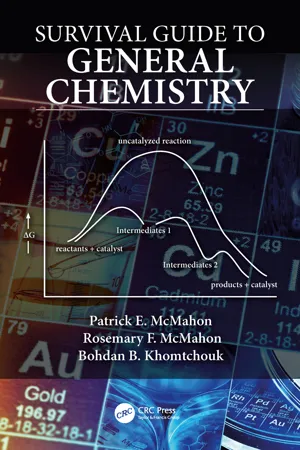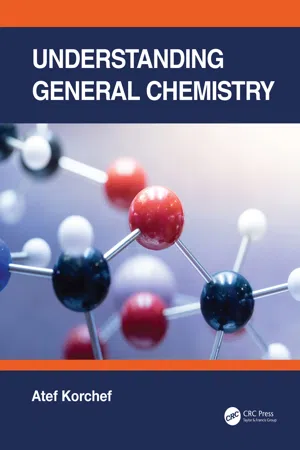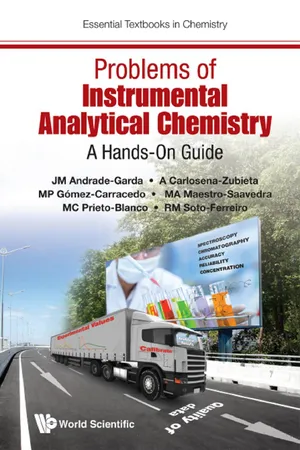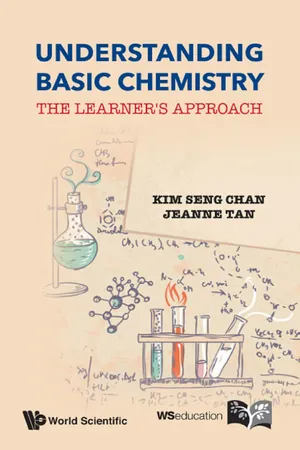Chemistry
Molar Mass Calculations
Molar mass calculations involve determining the mass of one mole of a substance, typically expressed in grams per mole. This is done by adding up the atomic masses of all the atoms in a molecule. The molar mass is an important concept in chemistry for converting between the mass of a substance and the number of moles present.
Written by Perlego with AI-assistance
Related key terms
Related key terms
1 of 4
Related key terms
1 of 3
7 Key excerpts on "Molar Mass Calculations"
- eBook - ePub
- Jeffrey Gaffney, Nancy Marley(Authors)
- 2017(Publication Date)
- Elsevier(Publisher)
The molar mass is used to convert the mass of a substance in grams to the number of moles or to convert the number of moles of a substance to its mass in grams. For example, if the mass of substance A is known, the number of moles of substance A can be calculated by;= moles Agrams Amolar mass Ag / molSimilarly, if the number of moles of substance B is known, the mass of substance B can be calculated by;(2)moles B × molar mass Bg / mol= grams B(3)Example 4.1: Determining the Number of Moles of a Compound From Its Mass How many moles are there in 15.0 g of sodium chloride? How many moles of sodium ions are there in the same sample? How many moles of chloride ions?1. Determine the molar mass of NaCl.The atomic mass of Na = 23.0 amu, the atomic mass of Cl = 35.5 amu The molar mass of NaCl = 23.0 + 35.5 = 58.5 g/mol2. Convert grams of NaCl to moles of NaCl.= 0.256 moles Nacl15.0 g58.5 g / mol3. Determine the number of moles of ions.NaCl has one sodium ion and one chloride ion. 15.0 g NaCl = 0.256 moles of sodium ions and 0.256 moles of chloride ions.Example 4.2: Determining the Mass of a Compound From the Number of MolesHow many grams are in 0.700 moles of hydrogen peroxide (H2 O2 )?1.The atomic mass of H = 1.01 amu, the atomic mass of O = 16.0 amu.Determine the molar mass of H2 O2 :The molar mass of H2 O2 = (1.01 × 2) + (16.0 × 2) = 34.0 g/mol2. Convert moles to grams:0.700 mol × 34.0 g/mol = 23.8 grams of H2 O2 in 0.700 moles.4.2 The Empirical Formula
While the molecular formula of a compound shows the number of each type of atom in a molecule, the empirical formula shows the simplest positive integer ratio of atoms present in the compound. As such, the empirical formula does not necessarily represent the actual numbers of atoms present in a single molecule of the compound. For example, the molecular formula for sulfur monoxide is SO and the molecular formula for disulfur dioxide is S2 O2 - Albert S. Tarendash(Author)
- 2021(Publication Date)
- Barrons Educational Services(Publisher)
Chapter Fourchemical calculations
Key Ideas
This chapter focuses on problem solving in chemistry. The concept of the mole is stressed throughout the chapter. A variety of problems involving single substances and equations is explored.KEY OBJECTIVES
At the conclusion of this chapter you will be able to:- Define the terms atomic mass unit, isotopic mass, and average atomic mass.
- Calculate the atomic mass of an element, given the masses of its naturally occurring isotopes and the abundances of these isotopes.
- Calculate the formula mass of a substance.
- Define the term mole in relation to number of particles and the mass of a substance.
- Define the term molar mass (also called gram-formula mass).
- Calculate the molar masses of various types of substances.
- Solve mole-mass problems.
- Solve percent composition problems.
- Calculate the molecular formula of a substance, given its empirical formula and molar mass.
- Calculate the empirical formula of a substance from its percent composition by mass.
- Solve mole and mass problems involving chemical equations.
- Solve problems involving percent yields and limiting reactants.
Passage contains an image
SECTION I—BASIC (REGENTS-LEVEL) MATERIAL
NYS REGENTS CONCEPTS AND SKILLS
Note: By the time you have finished Section I, this chapter, you should have mastered the concepts and skills listed below. The Regents chemistry examination will test your knowledge of these items and your ability to apply them.Concepts are the basic ideas that form the body of the Regents chemistry course (what you need to know!).Skills are the activities that demonstrate your mastery of these concepts (how you show that you know them!).Following each concept or skill is a page reference (given in parentheses) to this chapter.4.1 Concept: The mass of each proton and of each neutron is approximately equal to one atomic mass unit. An electron is much less massive than a proton or a neutron. The mass of an atom is very nearly equal to its mass number. (Pages 83–84 - eBook - ePub
- Patrick E. McMahon, Rosemary McMahon, Bohdan Khomtchouk(Authors)
- 2019(Publication Date)
- CRC Press(Publisher)
compound is defined as the mass of one mole of molecules or formula units.The molar mass (MM) of any compound is numerically equal to the molecular mass or formula unit mass of the compound expressed in gram units; the units of MM = grams/moles.Molar mass is most often used directly in calculations. The molar mass (MM) = sum of the molar masses of each atom (in gram units) in the molecule or each atom (in gram units) in the simplest whole number ratio formula.Example:MM of CuCl 2( ionic compound ): 1 Cu × 63 .54 g/mole = 63 .54 grams/mole+ 2 CI × 35 .45 g/mole =70 .90 grams/mole_total =1 3 4. 4 4 g / m o l eExample:Counting all the atoms in formulas containing polyatomic ions requires care.MM of CO 2( molecule ) : 1 C × 12 .01 g/mole = 12 .01 grams/mole+ 2 0 × 16 .00 g/mole =32 .00 grams/mole_total =4 4.0 1g /m o l eExample:MM of Co 3(2PO 4)( ionic compound ): 3 Co × 63 .54 g/mole = 176 .70 grams/mole+ 2 P × 30 .97 g/mole = 61 .94 grams/mole+ 8 O × 16 .00 g/mole =128 .00 grams/mole_total =3 6 6. 7 3 g / m o l eCertain elements come in the form of molecules. The molar mass of elements, which come in the form of molecules, is based on the formula of the complete molecule.MM of O2 (element comes as a molecule): 2 O × 16.00 g/mole = 32.00 g/molePROCEDURE FOR SOLVING MOLE PROBLEMS (COMPOUNDS )(1) Identify the correct form of the [MM = mass(g)/moles] equation, which is required to solve for the unknown variable.(2 - eBook - ePub
- Atef Korchef(Author)
- 2022(Publication Date)
- CRC Press(Publisher)
weight) percent refers to the ratio of the mass of one element to the total mass of a compound. The mass percent of an element, % (element), is determined bythe following equation:
where n is the number of atoms of the element in the compound.%=e l e m e n t× 100n × a t o m i c m a s s o f t h e e l e m e n tm o l e c u l a r m a s s o f t h e c o m p o u n dA balanced chemical equation is an equation that represents the correct amounts of reactants and products in a chemical reaction. The number of atoms of each element is the same on both sides of the equation. To balance achemical equation, start by balancing those elements that appear in only one reactant and one product.- Example of a balanced chemical equation: 2HgO → 2Hg + 1/2O2
Stoichiometry is the study of mass relationships that exist between reactants (substances consumed) and products (substances produced) in a chemical reaction. Use coefficients in the balanced equation to determine the relationships between the number of moles of reactants andproducts. Then, calculate the number of moles and the mass of the desired quantity.A solution consists of a smaller amount of a substance, the solute, dissolved in a larger amount of another substance, the solvent.The concentration of the solution is expressed as the amount of solute dissolved in a given amount of solution. The term most used is Molarity (M), defined as number of moles of solute per liter of solution (M = n/V). A common unit of molarity is M(= mol L−1 ).The molality is defined as the number of moles of the solute per kilogram of the solvent. The SI unit of molality is mol kg−1 .The solubility designates the maximum mass concentration of the solute in the solvent, at a given temperature. The solution thus obtained is saturated. The solubility depends on temperature and may be expressed in g L−1 , mol L−1 and g 100 g−1 - eBook - ePub
Problems of Instrumental Analytical Chemistry
A Hands-On Guide
- JM Andrade-Garda, A Carlosena-Zubieta;MP Gómez-Carracedo;MA Maestro-Saavedra;MC Prieto-BlancoRM Soto-Ferreiro(Authors)
- 2017(Publication Date)
- WSPC (EUROPE)(Publisher)
According to IUPAC, the term concentration includes four quantities characterizing the composition of a mixture with respect to the volume of the mixture [ 4 ]: mass, amount, volume and number concentration. Also, the term concentration is a shortcut for amount-of-substance concentration or amount concentration. The SI unit for the amount of substance is the mole (n): defined as the amount of substance of a system which contains as many elementary entities as there are atoms in 0.012 kilogram of carbon- 12 [ 2 ]. IUPAC recommends that this physical quantity (’amount of substance’) is no longer called ‘number of moles’, just as the physical quantity ‘mass’ should not be called ‘number of kilograms’. This unit is selected so that the atomic mass (expressedinthe unified atomic mass unit, u) and the molar mass (in grams/mol) have the same numerical value (Note: the abbreviation amu is not an acceptable unit symbol nowadays for the unified atomic mass unit). In general, the calculations that involve moles of a substance require the use of the molar mass of that substance. The terms atomic weight and molecular weight are obsolete and, thus, should be avoided. They have been replaced by the equivalent but preferred terms relative atomic mass and relative molecular mass, respectively, which are simple dimensionless numbers. When they are expressed as g/mol, they are designated as molar mass, represented by M, for both atoms and molecules. The concentration or amount-of-substance concentration (c A) is the amount of a substance, A, divided by the volume of the mixture in which it is present: c A = n A / V. The common unit is mol/dm 3 or mol/L. Molarity (M) is commonly used instead of these terms. Thus, the molarity for a 0.5 mol/dm 3 solution is said to be 0.5 M (0.5 molar solution). However, NIST’s Guide [ 3 ] prefers the original term because it is unambiguous; they recommend that the term molarity and the M symbol should no longer be used because they are obsolete - eBook - ePub
Understanding Basic Chemistry
The Learner's Approach
- Kim Seng Chan, Jeanne Tan(Authors)
- 2014(Publication Date)
- WSPC(Publisher)
CHAPTER 4MOLE CONCEPT, FORMULA, AND STOICHIOMETRYIn Chapter 3 , we learned that matter is made up of fundamental particles such as an atom, ion, or molecule. But these particles are extremely small objects, both in size and mass. If the mass of a small toothpick is about 1.00 × 10−2 g, the mass of a hydrogen atom (1.67 × 10−24 g) is 1.67 × 1022 times lighter than the mass of the toothpick. Or if your mass is 10 kg, you are about 5.97 × 1024 times lighter than the mass of our planet Earth.Atoms and molecules react in specific ratios to form compounds. In the laboratory, however, chemists work with bulk quantities of reactants, which are measured by mass. They need to know the relationship between the mass of a given sample and the number of atoms or molecules contained in that mass of a given sample. So, how do scientists know the number of particles in the mass of a matter in the laboratory? How many ions are present in a tablespoon of salt? How many molecules are present in a dew drop? How many atoms are present in a speck of sand? A standard for counting such small particles is needed!4.1 The MoleThis standard is known as the “mole.” The mole is based upon the carbon-12 isotope. In the beginning, scientists asked the following question: how many carbon-12 atoms are needed to have a mass of exactly 12 g (recall that scientists had already developed the concept of relative atomic mass)? So, what is this number?The number is known as the Avogadro’s number, L or NA , in honor of Amedeo Avogadro, though the number was not formulated by him. In fact, he just conceptualized the idea. Thus, L is defined as:Careful measurements yield a value of 6.022141 × 1023 mol−1 . It is difficult to imagine how large this number is. Let us try: if you have 6.02 × 1023 one-dollar notes and each day you spend $1,000, you are going to need 6.02 × 1020 days or 1.64 × 1018 years to finish it. The age of Earth is just about 4.54 × 109 - No longer available |Learn more
- Steven Boone, Drew H. Wolfe(Authors)
- 2011(Publication Date)
- Collins Reference(Publisher)
CHAPTER 4Stoichiometry
4.1 THE MOLE CONCEPTThe mole is a base SI unit for the amount of substance. The Mole a Counting UnitWhat is a mole, and how is it applied in chemistry? A mole , abbreviated mol, is a counting unit, a unit that allows us to keep track of the number and mass of atoms, molecules, and ions.MolesThe number of objects in one mole is 6.022 × 1023 . This number is called Avogadro’s number and may be abbreviated: NA , where NA = 6.022 × 1023 particles/mole.What is the importance of Avogadro’s number, 6.022 × 1023 ? If a sample of an element contains 6.022 × 1023 atoms, its mass equals the atomic mass in grams. In all cases, one mole of atoms contains Avogadro’s number of atoms, which has a mass equal to the atomic mass in grams.The SI definition for a mole is as follows: One mole is the amount of pure substance that contains the same number of particles as there are atoms in exactly 12 g of 12 C.Molar Mass of AtomsThe molar mass of an element is obtained by writing the value for the atomic mass (from the Periodic Table), and placing the unit grams after the number.Exercise 4.1(a) What are the molar masses expressed to four significant figures of each of the following elements: As, Kr, Na, Al? (b) How many atoms are in the molar masses of each of the elements listed in (a)?Solution 4.1Mole Calculations Involving Elements(a) 74.92 g/mol As, 83.80 g/mol Kr, 22.99 g/mol Na, and 26.98 g/mol Al, (b) These samples each contain Avogadro’s number of atoms, 6.022 × 1023 atoms.The advantage of using moles is that after making a simple mass measurement in a laboratory, the investigator may readily calculate the number of moles of atoms or individual atoms in the sample. Mole calculations are easily carried out using the factor-label method (unit-conversion method).
Index pages curate the most relevant extracts from our library of academic textbooks. They’ve been created using an in-house natural language model (NLM), each adding context and meaning to key research topics.
Explore more topic indexes
Explore more topic indexes
1 of 6
Explore more topic indexes
1 of 4






